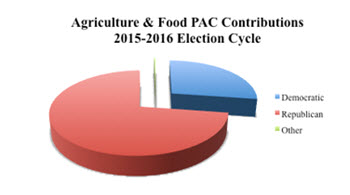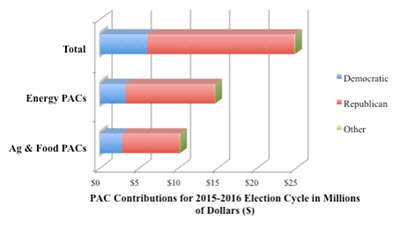WASHINGTON, March 30, 2016 - Agriculture, food and energy industry Political Action Committee (PACs) are preparing in a big way for the upcoming presidential election, having already contributed a combined $24.9 million to political candidates in the first half of the 2015-2016 election cycle.
Farm groups and agribusinesses, along with food manufacturers, processors, retailers and their associations contributed just shy of $10.2 million to political campaigns in 2015. Almost three-fourths of those PAC dollars – 72 percent – went to Republican candidates, according to Federal Election Commission data assembled by the Center for Responsive Politics.

In the last, two-year midterm election cycle (2013-2014) ag and food PACs put up $21.2 million, while energy PACs contributed almost $32 million. Comparing those figures to the first year of the 2015-2016 cycle, and taking into account that total PAC contributions have increased every election cycle since 1990, it’s possible ag PAC dollars over the full 2015-2016 cycle will add up to a greater sum than ever before.
“PAC contributions are one tool we use” to develop relationships with candidates, Jon Doggett, executive vice president for the National Corn Growers Association, told Agri-Pulse. “But it’s not the number one tool,” or even the number two or three tool, he said. “We use it selectively… to support our friends that have supported us.”
Little surprise then that House Agriculture Committee Chairman Mike Conaway, R-Texas, was the top recipient of PAC money from agricultural interests in 2015, taking in more than $316,000 – more than half of his total PAC receipts of $611,000, and just shy of what he collected in ag PAC contributions ($390,000) during the entire 2013-2014 cycle. Among his top ag contributors were the American Pistachio Growers ($10,000); Bayer AG ($10,000); the Farm Credit Council ($10,000); the National Turkey Federation ($10,000) and the United Fresh Produce Association ($10,000).
Conaway also received about $42,500 in contributions to his campaign committee from energy PACs, mostly split between oil and gas companies and electric utilities.
Rep. Robert Aderholt, R-Ala., chairman of the ag appropriations subcommittee, received $140,000 in ag PAC contributions, with American Crystal Sugar contributing $10,000; Farm Credit Council, $8,000; and Alabama Farmers Federation, $7,000.
Rep. Collin Peterson, D-Minn., the ranking member on the House Ag Committee, collected $209,525 in PAC funds from ag groups. Top contributors were Land O’Lakes ($10,500), the American Association of Crop Insurers ($10,000), the National Turkey Federation ($10,000), and the Southern Minnesota Sugar Beet Cooperative ($10,000).
On the Senate side, Ag Committee Chairman Pat Roberts,
R-Kan., received $69,250
in PAC contributions from agricultural interests. Roberts, who is not up for
re-election until 2020, received
Debbie Stabenow, D-Mich., ranking member on the Senate Ag Committee, has taken in $101,068 from ag-related groups, including $20,000 from Land O’Lakes, $18,500 from the American Soybean Association, and $15,500 from Monsanto. Stabenow is not up for re-election until 2018.
As ag interests look to expand their spheres of influence, several members of the Congressional Black Caucus (CBC) also benefited from agricultural donations. CBC member David Scott of Georgia, the number-two Democrat on the House Agriculture Committee, picked up $62,500 in contributions from ag PACs in 2015, while Rep. Marcia Fudge, D-Ohio, also an Ag Committee member, collected $37,000.
Rep. G.K. Butterfield, D-N.C., a co-sponsor of the bill to pre-empt labeling of genetically engineered foods, took in $35,681 from ag PACs. Butterfield, the chairman of the CBC, also serves on the Energy and Commerce subcommittee, dealing with biotech labeling and food safety. Twenty of the 46 members of the CBC – all but one a Democrat – voted for the bill, which passed 275-150, with only 45 Democratic votes in favor.
The top five contributing ag PACs in 2015 nearly match the last cycle: American Crystal Sugar led with $1,060,500 in contributions; Farm Credit Council ($605,640); the National Cattlemen’s Beef Association ($472,000); Deere & Co. ($420,750), and Michigan Sugar ($278,750), which edged out Monsanto for fifth place.
Energy PACs were once again led by the National Rural Electric Co-op Association ($1,038,675), followed by Koch Industries ($794,400) and Exxon Mobil ($681,250).
To see a complete list of ag, food, and energy PAC contributions, click here.
#30
For more news, go to: www.agri-pulse.com